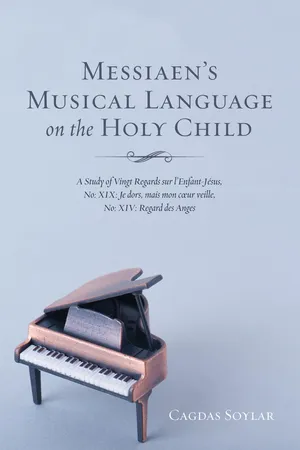![]()
1.
General Biographical Description
Messiaen’s Life
Olivier Messiaen, French composer, organist, ornithologist, and teacher, was born on December 10th, 1908, in Avignon, and died on April 27th, 1992, in Paris. A child prodigy, Messiaen began composing at the age of eight. He studied the piano during his childhood with Gontran Arcouët and Robert Lortart, and studied harmony with Jehan de Gibon. In 1919, he enrolled in the Paris Conservatory where he studied the organ with Marcel Dupré, one of the greatest organists of all time. He left the conservatory in 1931, however, and started working as an organist in the Church of La Sainte Trinité, where he held that position until his death. Messiaen also taught at the École Normale de Musique and at the Schola Cantorum.
At the outbreak of World War II, Messiaen enlisted in the army. Shortly after, he was taken prisoner by the Germans at Görlitz in Silesia and spent the following years (1940–1941) in a prisoner of war camp. Here, he composed his major work, Quatuor Pour la fin du Temps (Quartet for the End of Time). The work was composed for himself, to perform at the piano, and a violinist, a cellist, and a clarinetist, who were also prisoners. They performed their first concert at the camp in the winter of 1941. In the same year, Messiaen was released from the camp. After the war, he started teaching harmony at the Paris Conservatory. Pierre Boulez, Karlheinz Stockhausen, and George Benjamin were his most notable students. In 1966, he became professor of harmony at the Paris Conservatory and retained the position until his retirement in 1978. He died in his sleep on April 27th, 1992, in Paris, at the age of 83.
Messiaen’s Catholic faith had the greatest influence on his musical achievements. He devoted himself almost exclusively to his religion, frequently using biblical symbols in his compositions to express his love to Jesus Christ.
Messiaen was also an ornithologist, spending a lot of his time in France and abroad transcribing different bird calls. This was an instinctive passion of his which he did for his own personal joy. He put both the rhythm and melody of bird calls in writing. In France, he could recognize fifty species by their songs; throughout Europe, he could recognize over five hundred others. He composed three masterpieces: Oiseaux Exotiques (1955–56) for winds and percussion, Catalogue d’Oiseaux (1956–57) for solo piano, and Chronochromie (1959–60) for large orchestra. In all of these, Messiaen uses bird calls as melodic material and a kind of musical representation for the holiness of nature. As he explains in his own words, “Among the artistic hierarchy, the birds are probably the greatest musicians to inhabit our planet.’’
Background of the Vingt Regards Sur l’Enfant-Jésus
The Vingt Regards sur l’Enfant-Jésus (Twenty Gazes upon the Infant Jesus), composed in 1944, is a masterpiece. The cycle is a good example of his devotion to the Catholic faith as it contains many theological elements and is also considered one of the most remarkable solo piano works of the twentieth-century.
The Vingt Regards, as an opus, is subdivided into four groups of five pieces. Every fifth piece addresses the Divinity. The first movement addresses God, the Father, while the fifth addresses God, the Son, and the tenth addresses God, the Holy Spirit. The fifteenth and twentieth movements both address God, the Son.
Messiaen uses three cyclical themes throughout the work. They are the “Theme of God,” the “Theme of the Star and the Cross,” and the “Theme of Chords.” The most important theme is the “God Theme,” first heard in the initial movement, “Regard du Père” (Gaze of the Father), as it makes up the entire movement. In the first Regard, the theme, which consists of a chordal progression, is in the lower register of the piano, at a pianissimo level. It also occurs in the fifth movement, “Regard du Fils sur le Fils” (Gaze of the Son upon the Son) and in the last movement, “Regard de l’Église d’amour” (Gaze of the Church of Love). The theme appears again, in incomplete forms, in movements six, ten, eleven and fifteen.
Figure 1. Thème de Dieu
1947 by Durand S.A. Editions Musicales, Paris
The Thème de Dieu, as a principle them...

